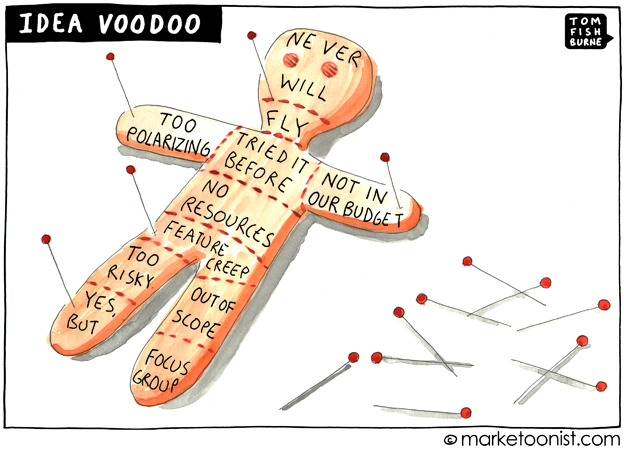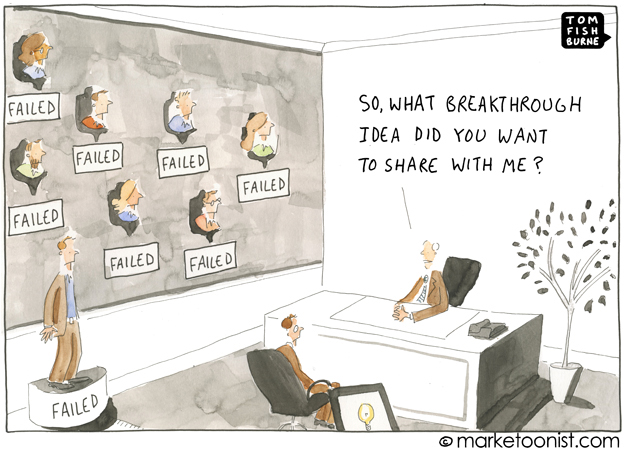Innovation Hell: Saving Good Ideas From Premature Death - Visualised | Fast Company
 Thursday, March 29, 2012 at 11:03AM
Thursday, March 29, 2012 at 11:03AM So many companies attempt innovation and miss the target. Brand identity expert David Brier worked with cartoonist Tom Fishburne to dissect where innovation goes off the rails and the three lessons you can use to get back on track.

Why is it that so many ideas grow weaker in the process that is theoretically designed to bring them to life? It's a painful but true phenomena (also, a very bad indicator of a company culture, if your goal is to survive and not become yesterday's news).
Innovation is the heaven and hell of every brand’s journey. Inspired insight and passion fuel innovation’s potential, while committees have the wonderful legacy of killing potential greatness faster than a roomful of politicians. Or worse, a committee of politicians.
Creativity Isn't The Enemy (Unless Progress Is Your Opponent)
As anyone whose been involved with any aspect of the creative (innovation) process knows, it's far easier to critique than to create, a distasteful truth for anyone who's gone through it, no matter which side of the table you're on.
Tom summarized it this way:

Shooting The Messenger
Too often, companies create or encourage a culture where those who take risks are often penalized. Yet truly great companies (with the accompanying customer loyalty and confidence) thrive in the presence of it, while potential superstar companies die for the lack of it.
Thankfully, innovation has survived due to some bullheaded visionaries who dared to ask "Why?"--resulting in everything from the light bulb to the telephone to FedEx (overnight shipping via a central hub) to the iPad. As business guru Peter Drucker wrote in Innovation and Entrepreneurship, “Innovation is the specific instrument of entrepreneurship...the act that endows resources with a new capacity to create wealth.” (Case in point: A recent report stated there are now more iPhones sold in the world each second than there are babies born. Talk about a family plan....)
Thus, the importance of inspiring innovation becomes a bottom line fundamental as well as a top line enhancer.

Innovation: Knowing When To Stop
Few CEOs have the skill of knowing where and when to innovate, failing to distinguish when simplicity is the right answer. The late great Steve Jobs had that skill, along with his chief designer Jonathan Ives.
Part of it is realizing you’re opening doors rather than building walls to keep out competition. It’s the difference between a Richard Branson approach to business versus the Donald Trump model.
How much is too much? You be the judge:

Price And Features Are Not The Answer
For example, Kickstarter reinvented the business startup industry in an economy where sources of funding had theoretically dried up, yet it sees up to more than $2 million pledged each and every week. Or the popular game-changing mobile app, Bump, which made information exchanging as easy as a fist bump (with 60 million downloads confirming its desirability). As Jack Dorsey of Square, whose product innovated shopping and its efficiency for retail businesses, stated recently, "Everything we do is about getting people to be more open, more creative, more courageous.”
So it's not price but value that separates true innovation from little band aids designed to cover up bigger issues. And in the spirit of Steve Jobs's famous mantra of people not knowing what they want until you show them...one ends with this type of nightmare in Innovation Hell:

The Lesson Learned
The lessons here are three:
- Innovation can be encouraged. More so, it must be.
- Innovation is the foundation that separates the great from the wannabe.
- The challenging of the status quo should not be the exception but the rule, possibly the only rule in the realm of innovation worth following.
Practice them liberally and win.
-------------------
Thanks to Tom Fishburne, founder and CEO of Marketoonist, a content marketing agency that develops cartoon campaigns for businesses such as Unilever, O2, Kronos, and the Wall Street Journal. He was previously a VP at Method, the innovative home care brand, and led brands at Nestle and General Mills. He learned how to draw cartoons at Harvard Business School. Sign up for his weekly marketoons at Marketoonist.com.
--This is the third in a series of posts on HELL and escaping its grasp. Stay tuned for upcoming installments including, How to Escape Innovation Hell, How to Escape Social Media Hell, and How to Escape Logo Hell.



Reader Comments